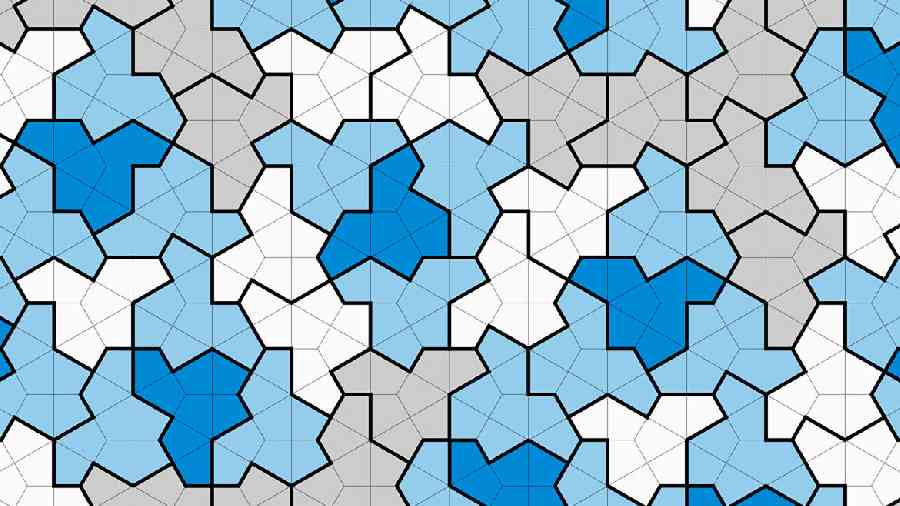Last November, after a decade of failed attempts, David Smith, a self-described shape hobbyist of Bridlington in East Yorkshire, the UK, suspected that he might have finally solved an open problem in the mathematics of tiling: that is, he thought he might have discovered an “einstein”.
In less poetic terms, an einstein is an “aperiodic monotile”, a shape that tiles a plane, or an infinite two-dimensional flat surface, but only in a non-repeating pattern. (The term “einstein” comes from the German ein stein or one stone — more loosely, one tile or one shape.) Your typical wallpaper or tiled floor is part of an infinite pattern that repeats periodically; when shifted, or “translated”, the pattern can be exactly superimposed on itself. An aperiodic tiling displays no such “translational symmetry”, and mathematicians have long sought a single shape that could tile the plane in such a fashion. This is known as the Einstein problem.
“I’m always messing about and experimenting with shapes,” said Smith, 64, who worked as a printing technician, among other jobs, and retired early. Although he enjoyed maths in high school, he didn’t excel at it, he said. But he has long been “obsessively intrigued” by the Einstein problem.
And now a new paper — by Smith and three co-authors with mathematical and computational expertise — proves Smith’s discovery true. The researchers called their einstein “the hat”, as it resembles a fedora. (Smith often sports a bandanna tied around his head.) The paper has not yet been peer reviewed.
“This appears to be a remarkable discovery!” Joshua Socolar, a physicist at Duke University, US, who read an early copy of the paper, said in an email. “The most significant aspect for me is that thetiling does not clearly fall into any of the familiar classes of structures that we understand.”
“The mathematical result begs some interesting physics questions,” he added. “One could imagine encountering or fabricating a material with this type of internal structure.” Socolar and Joan Taylor, an independent researcher in Burnie, Australia, previously found a hexagonal monotile made of disconnected pieces, which according to some, stretched the rules. (They also found a connected 3D version of the Socolar-Taylor tile.)
Initially, mathematical tiling pursuits were motivated by a broad question: was there a set of shapes that could tile the plane only nonperiodically? In 1961, mathematician Hao Wang conjectured thatsuch sets were impossible, but his student Robert Berger soon proved the conjecture wrong. Berger discovered an aperiodic set of 20,426 tiles, and thereafter a set of 104.
Then the game became: how few tiles would do the trick? In the 1970s, Sir Roger Penrose, a mathematical physicist at the University of Oxford, UK, who won the 2020 Nobel Prize in physics for his research on black holes, got the number down to two.
Others have since hit upon shapes for two tiles. “I have a pair or two of my own,” said Chaim Goodman-Strauss, another of the paper’s authors, a professor at the University of Arkansas, US, who also holds the title of outreach mathematician at the National Museum of Mathematics in New York.
“But then the Holy Grail was, could you do with one — one tile?” Goodman-Strauss said.

A new paper by David Smith and three others proves his discovery of an ‘Einstein’ shape
The paper provided two proofs, both executed by Joseph Myers, a co-author and a software developer in Cambridge, the UK. One was a traditional proof, based on a previous method, plus custom code; another deployed a new technique, not computer-assisted, devised by Myers.
Smith’s investigations were mostly by hand; one of his co-authors even described him as an “imaginative tinkerer”.
To begin, he would “fiddle about” on the computer screen with PolyForm Puzzle Solver, software developed by Jaap Scherphuis, a tiling enthusiast and puzzle theorist in Delft, the Netherlands. But if a shape had potential, Smith used a Silhouette cutting machine to produce a first batch of 32 copies from card stock. Then he would fit the tiles together, with no gaps or overlaps, like a jigsaw puzzle, reflecting and rotating tiles as necessary.
When in November he found a tile that seemed to fill the plane without a repeating pattern, he emailed Craig Kaplan, a co-author and a computer scientist at the University of Waterloo in Canada.
“Could this shape be an answer to the so-called ‘einstein problem’ — now wouldn’t that be a thing?” Smith wrote.
“It was clear that something unusual was happening with this shape,” Kaplan said. Taking a computational approach that built on previous research, his algorithm generated larger and larger swaths of hat tiles. “There didn’t seem to be any limit to how large a blob of tiles the software could construct,” he said.
With this raw data, Smith and Kaplan studied the tiling’s hierarchical structure by eye. Kaplan detected and unlocked telltale behaviour that opened up a traditional aperiodicity proof — the method mathematicians “pull out of the drawer anytime you have a candidate set of aperiodic tiles,” he said.
Kaplan of Canada clarified that “the hat” was not a new geometric invention. It is a polykite — it consists of eight kites. (Take a hexagon and draw three lines, connecting the centre of each side to the centre of its opposite side; the six shapes that result are kites.)
“It’s likely that others have contemplated this hat shape in the past, just not in a context where they proceeded to investigate its tiling properties,” Kaplan said. “I like to think that it was hiding in plain sight.”
NYTNS











